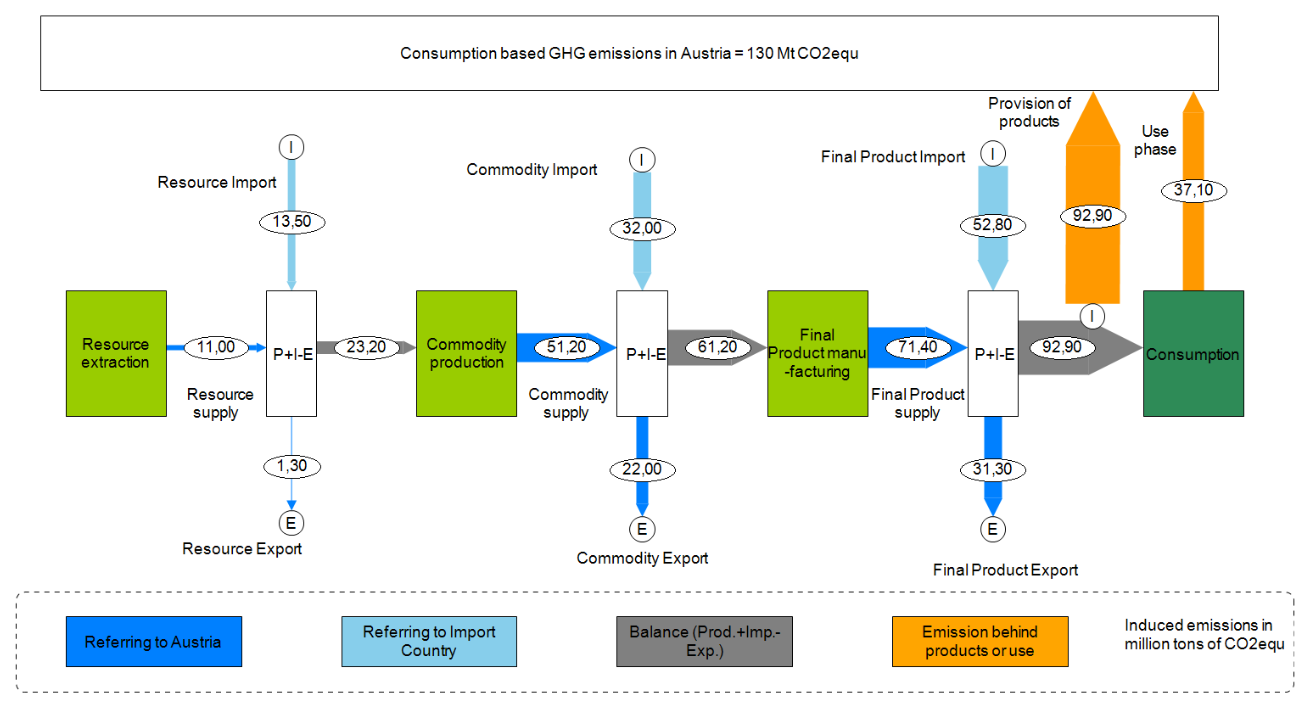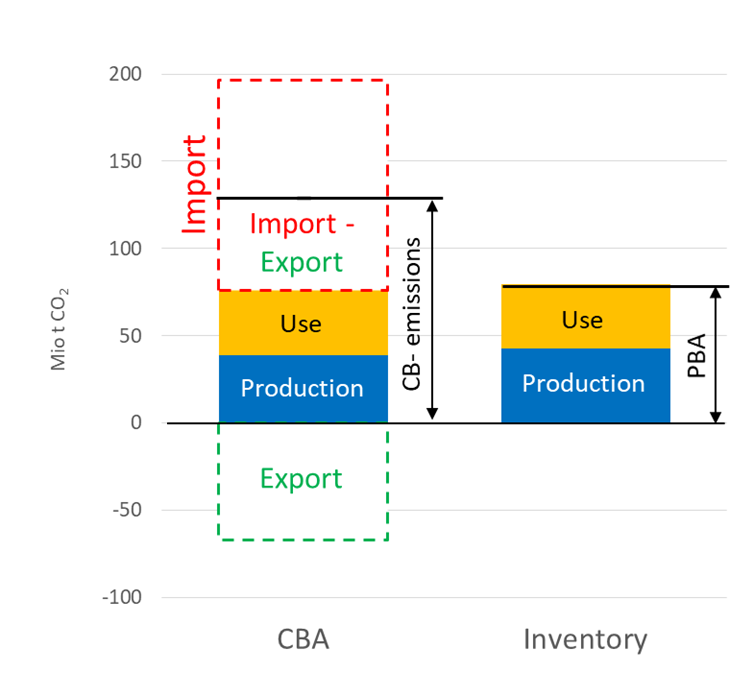Life cycle based greenhouse gas emissions of Austrian consumption
This project was funded by Austrian Climate Fund and is conducted in the frame of 7th Austrian Climate Research Programme
Back to Intro
| Background | The impacts of climate change are becoming more and more apparent in the last years and climate change is considered as one of the greatest challenges of our time. The major causes for this are the increasing greenhouse gas emissions (e.g. CO2, CH4, N2O) from anthropogenic activities. This dominant human influence was affirmed in the latest progress report of IPCC. Greenhouse gas emissions (GHGs) result mainly from burning of fossil energy, currently the dominant energy resource. When looking at the sectors responsible for the increasing climate relevant emissions, industrial production processes for manufacturing of commodities and consumer products emerge as one of the most important sectors, due to the dominant use of fossil resources as feedstock and energy intensive production processes. The knowledge of the sources of emissions is necessary for the rapid reduction of GHG emission on global level. With this information every state could implement suitable measures and policies to reduce emissions. Meanwhile most states conduct a greenhouse gas emission inventory on the national level. This type of a national GHG balance is an activity based approach which focuses on domestic production and on national boundaries. Impacts in foreign countries induced by foreign trade (e.g. import) are not considered therefore the total climate effects behind the real consumption of goods are not visible. It is difficult, therefore, to develop a comprehensive national strategy for global climate protection as essential climate effects of traded commodities and products are not considered. As climate change is a global challenge it is not enough to focus only on national boundaries as this favours the outsourcing of energy intensive production to countries with low technical standard and weak climate regulation and importing the products. Such an outsourcing normally results in better GHG balances for the importing country but in reality it often leads to a negative impact on global scale. So the currently used GHG accounting systems lead to a blurred picture of national climate impacts because of the missing attribution of the climate effects of imported and exported goods. For a serious climate protection both, the direct (inside national boundaries) emissions of one country but also emissions abroad induced by national consumption have to be considered. | |
| Objectives | This project looks at this topic and aims at complementing the national GHG inventory of Austria with emissions (CO2, N2O, CH4) from the foreign trade balance by considering imported and exported commodities and products additional to the national production activity. This shall bring a transparent picture of Austria's real climate impacts based on a consumption oriented approach with identifying outsourced production emissions and climate effects related to foreign consumption of domestically produced goods. Herewith the problem of "carbon leakage", which is specifically resulting from production based accounting through outsourcing of production, will be addressed in revealing the content to which a relocation of production and associated shift of embodied emissions through imported goods has occurred. This helps to identify the most urgent areas for climate protection measures, e.g. where outsourcing of energy intensive production induces increasing emissions globally through lower technical standard or weaker climate regulation than in Austria. | |
| Method | For the calculation and modelling of greenhouse gas emissions of Austrian consumption a bottom-up oriented approach on product level will be applied that uses a LCA-based approach supplemented with technology factors. Therefore the most energy and climate relevant basic materials behind the national consumption will be considered, as the production of basic materials in consumer products is most responsible for their energy and climate impact. Consequently the climate impact of national product´s consumption will be analysed by looking at the climate relevant emissions behind the production of the required basic materials for the consumed products. Therefore the flow of the basic materials in imported and exported commodities and products in combination with Austrian production will be investigated. From the material flow GHG emissions will be calculated with LCA data and technology factors. The LCA-based approach will be used to combine detailed trade data with adequate data from LCA databases to calculate the total greenhouse gas emissions or environmental impacts induced by imports and exports. These data will be supplemented with technology factors that allow a better illustration of different technological standards, energy mixes and emission intensities among the different countries of manufacturing. | |
| Results |
The following two graphics provide a quick overview about the project outcomes. Figure 1 shows the associated emissions to each element of the process chain. Figure 2 compares the total resulting emissions based on the projects methodology compared to the emissions based on the national inventory. 
Figure 1: Process chain GHG emissions of Austrian consumption Figure 1 and Figure 2 show clearly that more emissions are induced by imports than exports. The consumption based GHG emissions of Austria amount to almost 130 Mt of CO2equ. Figure one demonstrates how the emissions increase in the course of the chain from raw materials up to final products. This is characteristic for a process chain, as it is also described in LCA-data, as all impacts up to the considered good are included respectively. Overall more than 90 Mt of CO2equ (71%) are emitted through the provision of goods and only a minor part was emitted by the use of products (e.g. driving a car or heating). 
Figure 2: Emissions of consumption based accounting compared to the National Inventory Figure 2 shows the consumption based emissions (CBA) of Austria as compared to the national inventory (Inventory) for the year 2013 more clearly. As shown, emissions behind imports (red) dominate and emissions behind the national production (blue) are comparatively small. Anyway, the high technological standard of Austria, compared to those countries from which Austria imports, is a positive contribution to low GHG-emissions. From the calculations on a product level with adaptation of the emissions to the national situation in the producing countries it became evident, that the technological standard and the emission intensity of the respective energy mix in the countries play an important role for the total emission behind national consumption. It emerged that Austria performs well due to advanced technology, high energy efficiency and low emission intensity coming from a clean energy mix and a high share of hydro power in electricity production. So consumption of Figure 21: Distribution of consumption based emissions to consumption areas products made in Austria leads generally to lower emissions than imported products due to the favourable emission conditions and lower transport distances. | |

 Home
Home Das Institut
Das Institut Bereiche
Bereiche Publikationen
Publikationen News
News